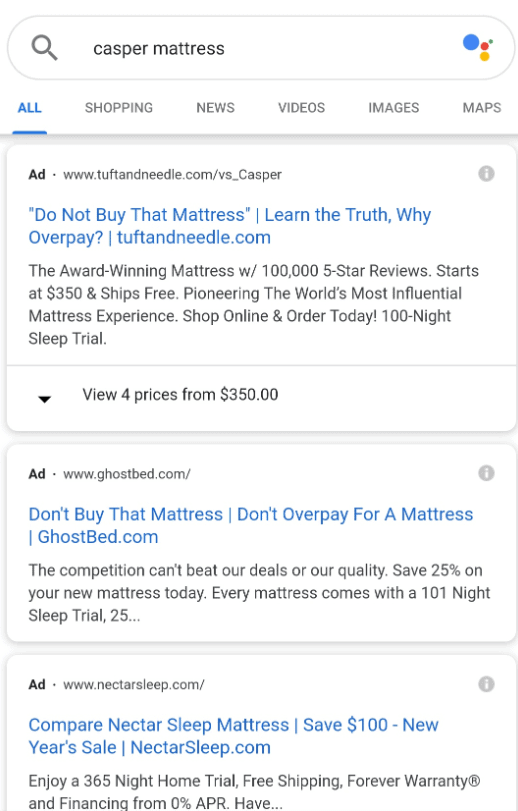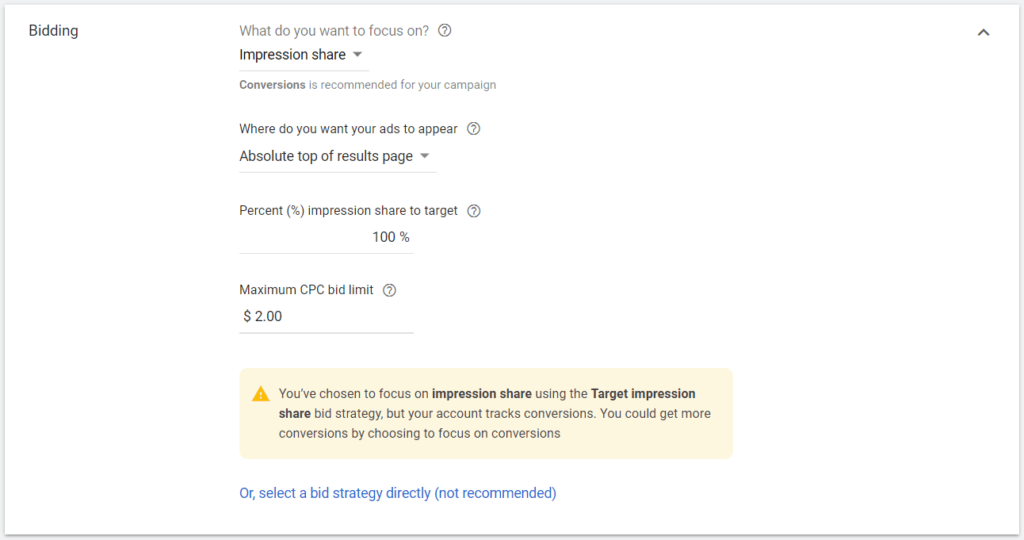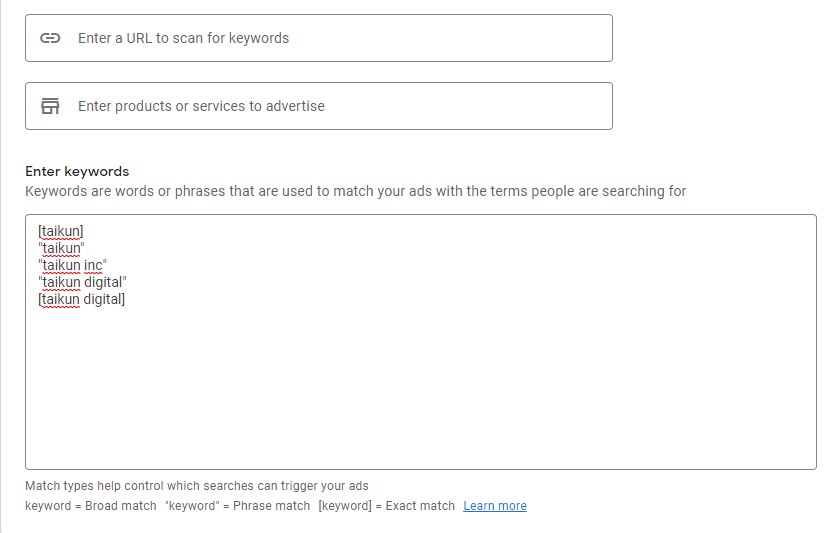
Why & How To Create A Branded Search Campaign
Branded campaigns offer the highest ROI opportunity on paid search. Here's why you need to setup a campaign how to set it up successfully.
If you pay some attention to the digital marketing industry, you have probably seen news coverage over the last 6 months relating to branded search campaigns. Arguments back and forth about whether it’s ethical they exist and why it’s necessary to have them.
And while I won’t wade into the ethics of whether or not there should be branded search campaigns, I will explain why you should have one setup and how to do it. In fact, setting up effective branded campaigns is one of the first things that we do for our PPC management clients.
Advantages of having a brand Search Campaign
Branded search campaigns are campaigns where, when someone searches for your branded terms, you have paid advertisements that show up. If you were to search for “Taikun Inc.” or “Taikun Digital” a paid search ad would show above the organic listings.
A natural follow up question is: “Why should I have paid ads on top of organic results where I rank #1?” Protecting your brand from your competitors is the most important reason for running branded search. There is nothing stopping one of your competitors from bidding on your branded keywords and having their ads show at the top of the results. This is the primary point that people bring up when it comes to the ethics of these campaigns. It makes sense that if someone is searching for your company name, then they are very interested in what you are offering. The data shows this with branded search campaigns outperforming all other paid advertising campaigns. One additional reason for why these conversion rates are high, and potentially higher than your organic results, is that you’re able to control what landing pages your visitors reach by utilizing sitelinks and the destination URL for the ads themselves. Even if you have a very strong organic search presence, your ads are likely to be driving net extra conversions. Google conducted a study back in 2011 which showed that 89% of all clicks on ads were incremental over organic clicks. This means that only 11% of people clicking on the ad would click on the organic result if the ad weren’t there. It’s important to note that this study is older, but the basic rules have not changed. If anything, the importance of search ads has increased. Finally, these ad campaigns are extremely low cost. Even if you have objections to the necessity of running a branded search campaign from an ethical standpoint–and we understand if you do–the fact is that branded search campaigns are incredibly cheap. You’re going to have extremely high quality scores (almost always 10/10) which means affordable clicks. Now that we’ve established a few powerful reasons why you should have a branded search campaign setup, let’s get started on creating this campaign. I’m going to assume for the sake of this guide that you’ve created a Google Ads search campaign before, but if you haven’t, you should read this step-by-step guide first. To start, we are going to want to create a search campaign. On the first screen our steps are simple: The campaign name can be whatever you like, but you will want to include the words “Brand Search” somewhere. Always make sure to uncheck search partners and display network since those are trash. For branded search campaigns, you want to be more open with your geo-targeting options. These are people looking specifically for your brand, so you can be broad. Depending on your business, national or even global targeting are great. One of the key differences when running a branded search campaign is our bidding strategy. With most campaigns we want to focus on conversions but with branded search we don’t. We want to focus on impression share. This is because we want to make sure that our ad is showing at the top of the search results every single time someone searches for our brand. If we use one of Google’s other strategies, then we are going to lose out on impressions because Google is optimizing for something else. And because branded searches are 10/10 quality score matches, your costs are going to be extremely low. Max CPCs limits for your branded search can be set to a few dollars in almost all instances. Next up is the strategy for building out the ad groups for our branded search campaign. How we do that depends on factors including type of business and volume of branded search traffic that the business gets. I’ll go over the two most basic ad group structures for branded search. The most common and easiest setup for a branded search campaign has one ad group. One ad group is ideal for businesses that provide one type of service or have limited branded search traffic. This structure is the right structure for most businesses. At Taikun, we use this strategy. We provide PPC services, and we don’t get much branded search traffic, so this works for us. Setting up your ad group this way is easy. You simply add all your brand terms into the one ad group. As you can see, I have a few different keywords in here. It is my general recommendation that you want to use exact and phrase match for your full brand name, in our case Taikun Digital, and then phrase match for a truncated version of your name. If your brand root is pretty unique, as ours is, it can make sense to add the exact match for the root. In general, you don’t want to add broad match for your brand search campaigns. For us taikun will likely match for lots of “tycoon” terms which are not at all relevant. For businesses with lots of traffic and varieties of products or services, you’re should use a more advanced ad group structure. This is particularly important for e-commerce companies that sell multiple product lines across genders & ages. To further explain the structure, I’m going to use an example of a baby shoe company that sells shoes and socks for girls and boys age 0 to 3. In order to direct visitors to where they want to go, we want to segment the ad groups based on searcher queries. What this looks like in practice is 5 different ad groups for: The general ad group contains searches for the generic brand term, which covers lots of different basics. So if someone searches for things like “Acme,” “Acme promo,” “Acme shipping policy” these will be triggered by the generic ad group. This ad group also has negative keywords for the other ad groups (boys, girls, shoes, and socks) to ensure that searchers are reaching the correct ad group. For the shoe queries ad group, we will have the ads link to the top level shoe category with sitelinks for size breakdowns like 0-6 months, 6-12 months, and other relevant links to people searching for shoes. And this ad group will serve queries like: As you can see by those examples, this does not include queries for boys, girls, or socks. We have those as negatives to ensure those queries go to their dedicated ad groups. The socks ad group is structured the same way. For the boys and girls ad groups, the landing page for the ads are the gender category as that is most relevant to these searches. This is combined with sitelinks for the gender’s shoes based on size as well as gender-based socks. Queries that would be lumped into these ad groups would be: This more advanced structure can get as broad as necessary based on your traffic and product segmentation. In general, the basic rules for writing good search ads are applicable for branded search campaigns as well. There is one big difference however. With non-branded searches, you are trying to convince searchers why they should choose your business over your competitors; whereas, with a branded search campaign, they’re already looking specifically for your business. These search queries are at the very bottom of the funnel, so your copy should focus on information that encourages these people to convert. For someone who is searching for a PPC agency, our reasonable pricing and decade of experience are going to be relevant to getting that click. If they already know about us, they are probably familiar with our reputation and value proposition. So we might want to include something like “Get your free proposal in 24 hours.” When creating your extensions for branded search campaigns, the same rules apply as for non-branded campaigns. You should leverage as many relevant extensions as you can, including: While other extensions might also be relevant to your business, those three are relevant to almost every business. Utilizing the full range of ad extensions available is especially beneficial for your branded search queries because the buyer intent is highest. One of the most important changes that you need to make is to your non-brand campaigns. You must add your brand terms as negative keywords for your non-brand campaigns. This ensures that brand queries are only being served against your branded search campaign. By pulling your branded queries out of your non-brand campaigns, you will notice a decrease in performance for these campaigns. This is because branded searches are typically the highest ROI searches. The benefit of this is that you will get a more accurate picture of the ROI of the non-branded search campaigns and can make changes based on this more accurate data. If you’ve followed the guidance I’ve shared, you will have a good branded search campaign setup. It leverages the highest ROI search traffic your business will get, it is extremely affordable, and it protects your brand against competitors bidding on your terms. It’s important to monitor your branded search campaigns performance as you do with all other campaigns, though it requires less frequent analysis and modification. I won’t weigh in on whether it is right for Google and other search engines to allow for competitors to bid on branded terms, but the low cost and the ability to control which pages searchers can reach is reason enough to run a branded search campaign. If you have any questions, please don’t hesitate to comment below or get in touch with me at collin@taikundigital.com. Sign up for our newsletter

Blocking Competitor Bidding

High Conversion Rates

Increased Conversions
Low Cost
Creating Your Branded Search Campaign
Campaign Settings
Location Targeting

Bidding Strategy

Ad Group Strategy
Basic Ad Group Structure

Advanced Ad Group Structure

Writing Your Ads
Creating Extensions
Additional Account Modifications
Success with Branded Search
Related Articles

- PPC
A Winning Google Ads Setup For DTC Brands
Most ecommerce brands view Google as an afterthought behind Meta. They think that Google is not a strong acquisition channel for…

- Social Ads
- PPC
How Meta & Google Complement Each Other
Learn how Google & Meta Ads work synergistically to complete the buyer's journey.

- PPC
Google is Robbing You… and You Can’t Stop Them
If you’re advertising on Google, they’re reaching their hand into your pocket and jamming money into theirs.
How can we help you grow?



Sign up for our newsletter
Ready to make more money with digital ads?
Good. You’re on the right track. Get started by filling out this form.
"*" indicates required fields
